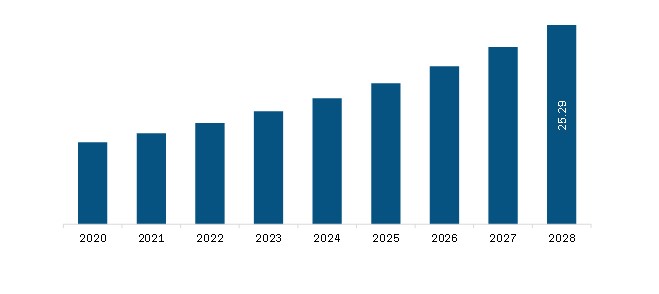The Middle East and Africa (MEA) radiation dose management market is expected to reach US$ 25.29 million by 2028 from US$ 11.52 million in 2021. It is estimated to grow at a CAGR of 12.4% from 2021 to 2028.
The growth of the market is due to growing focus on interventional radiology and nuclear medicine and rising cases of cancer demanding radiation therapy. However, organizational challenges and lack of benchmarking for dose optimization is expected to restrict the market growth during the forecast period.
Rapid advances in medical technology, device manufacturing, and imaging equipment have resulted in the refinement of original procedures with better techniques and an expansion of the indications for procedures. New techniques have been developed, and some techniques are migrated to other imaging modalities. More interventional radiological and nuclear medicine procedures are performed worldwide with high imaging efficiency. These procedures use high doses of radiation, and a longer duration may increase the risk of cancer in patients undergoing these procedures.
As reported by the World Nuclear Association, more than 10,000 hospitals worldwide use radioisotopes in medicine, and 90% of radioisotope procedures are diagnostic.
Market players, such as Bayer Healthcare and Sectra Medical Systems, offer dose management software specifically for RDM in interventional imaging and nuclear medicine. Although CT applications account for a larger share of the radiation dose management market, interventional radiology and nuclear medicine applications are expected to provide significant growth opportunities in the near future.
Also, according to National Library of Medicine, about 30‒50% of all cancer patients receive radiation via chemotherapy and surgery. Therefore, around 7 million patients worldwide receive radiation therapy every year. Three-dimensional images of cancer are formed by CT or MRI scans, further enabling accurate targeting for radiation therapy. According to International Journal of Medical Sciences, radiation therapy is the most effective non-surgical treatment for cancer; it accounts for only 5% of total cancer treatment expenditures. Almost 40% of cancer patients prefer radiation therapy and 16% are cured by the therapy. Therefore, the growing number of cancer cases and rising demand for radiation therapy are factors expected to drive the radiation dose management market.
Middle East and Africa Radiation Dose Management Market Revenue and Forecast to 2028 (US$ Mn)

- This FREE sample will include data analysis, ranging from market trends to estimates and forecasts.
MIDDLE EAST AND AFRICA RADIATION DOSE MANAGEMENT MARKET SEGMENTATION
The Middle East and Africa radiation dose management market, by service or software, is segmented into radiation dose management services and radiation dose management software. The Middle East and Africa radiation dose management market, by medium, is segmented into computed tomography, radiation, and mammography, fluroscopy and mammography, and other medium. Based on end user, the Middle East and Africa radiation dose management market is segmented hospitals, research and medical institutes, others. Geographically, the Middle East and Africa radiation dose management market can be divided into South Africa, Saudi Arabia, UAE and Rest of Middle East and Africa.
FUJIFILM Holdings Corporation, Bayer AG, Bracco Imaging S.p.A, GE Healthcare, Koninklijke Philips N.V., Medsquare, Novarad Corporation, Sectra AB and PACSHealth, LLC are among the leading companies operating in the Middle East and Africa radiation dose management market.
Middle East and Africa Radiation Dose Management Report Scope
| Report Attribute | Details |
|---|---|
| Market size in 2021 | US$ 11.52 Million |
| Market Size by 2028 | US$ 25.29 Million |
| CAGR (2021 - 2028) | 12.4% |
| Historical Data | 2019-2020 |
| Forecast period | 2022-2028 |
| Segments Covered |
By Service/Software
|
| Regions and Countries Covered |
Middle East and Africa
|
| Market leaders and key company profiles |
|
- Historical Analysis (2 Years), Base Year, Forecast (7 Years) with CAGR
- PEST and SWOT Analysis
- Market Size Value / Volume - Regional, Country
- Industry and Competitive Landscape
- Excel Dataset
Recent Reports
Testimonials
Reason to Buy
- Informed Decision-Making
- Understanding Market Dynamics
- Competitive Analysis
- Identifying Emerging Markets
- Customer Insights
- Market Forecasts
- Risk Mitigation
- Boosting Operational Efficiency
- Strategic Planning
- Investment Justification
- Tracking Industry Innovations
- Aligning with Regulatory Trends






















 Get Free Sample For
Get Free Sample For